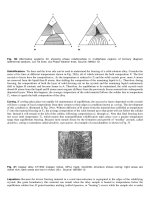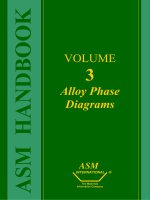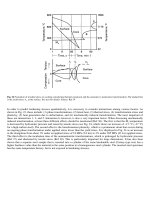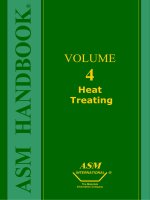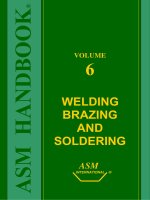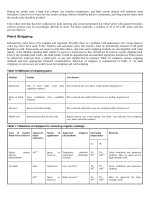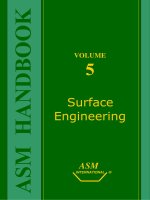ASM Metals Handbook - Desk Edition (ASM_ 1998) Episode 1 ppsx
Bạn đang xem bản rút gọn của tài liệu. Xem và tải ngay bản đầy đủ của tài liệu tại đây (870.99 KB, 180 trang )
ASM
INTERNATIONAL
Publication Information and Contributors
Metals Handbook Desk Edition, Second Edition was published in 1998. It was prepared under the direction of the ASM
International Handbook Committee. The Desk Edition was edited by Joseph R. Davis.
Editorial Advisory Board
• Peter J. Blau, Oak Ridge National Laboratory
• Rodney R. Boyer, Boeing Commercial Airplane Group
• Kenneth H. Eckelmeyer, Sandia National Laboratories
• Dennis D. Huffman, The Timken Company
• Lawrence J. Korb, Rockwell International
• David V. Neff, Metaullics Systems Company LP
• David LeRoy Olson, Colorado School of Mines
• Dennis B. O'Neil, Caterpillar Inc.
• Thomas S. Piwonka, University of Alabama
• S. Lee Semiatin, Wright Laboratory
• George F. Vander Voort, Buehler Ltd.
• Harry W. Walton, The Torrington Company
Foreword to the Print Edition
ASM International is proud to mark the 75th anniversary of ASM Handbooks. In 1923, the American Society for Steel
Treating (later the American Society for Metals, now ASM International) published a small loose-leaf collection of data
sheets the first edition of what became known as Metals Handbook. The series has developed over the years into a
multivolume collection of reference books each volume a thorough, comprehensive, and authoritative treatise on the
subject to which it is devoted. The series now titled ASM Handbook continues to evolve and expand to serve the
changing needs of metallurgy professionals throughout the world. One example of this evolution is the release this year of
the ASM Handbook on CD-ROM.
This year also marks the 50th anniversary of the classic 1948 edition of Metals Handbook the last "regular" edition to be
contained in one volume. The 1948 edition was the inspiration for the first Metals Handbook Desk Edition, published
almost 15 years ago. This Second Edition is intended to serve the same function as its two predecessors: to provide an
accessible, convenient, and practical single-volume first reference to all of metals technology.
It was with some trepidation that ASM International entered into the project to revise and update the Desk Edition. The
task seemed overwhelming. The ASM Handbook series had grown to 20 current volumes almost twice as many as were
in existence when the first Desk Edition was compiled. Would it be possible to create a work that included all of the vital
information from the first edition, plus the most significant knowledge and data compiled in the years since its release,
and still remain within the physical limits of a single volume?
We believe that the new Metals Handbook Desk Editionmore than meets that objective. The credit for this monumental
achievement belongs to Joseph R. Davis. Joe was Handbook Editor for many years at ASM, and his extraordinary
knowledge of the handbooks along with his considerable editorial skills made him uniquely qualified to oversee this
project. We are grateful to Joe for his hard work and for his commitment to creating the best Desk Edition possible. To
assist in this effort, Joe assembled an outstanding Editorial Advisory Board, made up of many longtime handbook
contributors and friends of ASM, and we extend our thanks to them as well. We also wish to recognize the ASM editorial
and production staff members for their dedicated efforts on this Volume.
Of course, we are especially grateful to the thousands of metallurgy professionals who have contributed to ASM
Handbooks over the past 75 years. Their willingness to share their knowledge and expertise as authors, reviewers,
volume organizers, and Handbook Committee members has made this book possible. With their ongoing support, ASM
Handbooks will continue to thrive for at least another 75 years.
Alton D. Romig, Jr.
President, ASM International
Michael J. DeHaemer
Managing Director, ASM International
Preface
The Metals Handbook Desk Edition is intended to serve as a comprehensive single-volume reference source on the
properties, selection, processing, testing, and characterization of metals and their alloys. Although the information
presented in this Volume is drawn principally from the 20 volumes of the ASM Handbook series, it should not be
considered simply an abridged version of the larger work. Instead, the Metals Handbook Desk Edition draws upon the
complete arsenal of ASM products both print and electronic as well as other key sources of information originating
from other publications, company literature, technical societies, and government agencies.
Volume Content
Because of the familiarity, success, and ease-of-use of the original Desk Edition published in 1984, it was determined
from the outset of the project that the editorial approach and outline for the new edition should follow in a similar manner.
The challenge in successfully revising the first edition was to determine what strategic additions (or reductions)and
improvements should be made. Complicating this task was the fact that a complete edition cycle of the ASM Handbook
(including completely new volumes on corrosion, tribology, materials characterization, and other topics) had been
published since the earlier edition was produced. To ensure that the best product possible resulted from the
revision/updating process, a 12-member Editorial Advisory Board representing industry, academia, and research
laboratories was formed. All board members have been key contributors to the Handbook series or have been involved
with other important ASM activities over the past decade. Under their guidance, an outline was established for the second
edition that divided the book into five major parts: General Information; Irons, Steels, and High-Performance Alloys;
Nonferrous Alloys and Special-Purpose Materials; Processing; and Testing, Inspection, and Materials Characterization.
General Information contains a glossary of more than 3000 terms, a collection of common engineering tables, and graphs
comparing properties of metals and nonmetals. It also includes contributions on crystal structure, practical uses of phase
diagrams, engineering design, and factors to be considered in the materials selection process.
Irons, Steels, and High-Performance Alloys. Emphasis is placed on properties and selection of ferrous alloys and heat-
resistant superalloys. Important relationships between structure and properties in irons and steels are described. The
effects of modern steelmaking practices on properties are examined, as is the influence of improved melting/refining
methods on superalloy performance. New or expanded information is presented on austempered ductile irons, high-
strength low-alloy steels, stainless steels(including duplex stainless steels), and powder metallurgy steels.
Nonferrous Alloys and Special-Purpose Materials comprises 14 major sections that describe the properties and selection of
conventional (structural) nonferrous alloys and materials used for such special-purpose applications as magnetic or
electrical devices, biomedical devices, and advanced aircraft/aerospace components. Metal-matrix composites and
structural intermetallics more recently developed materials not covered in the previous Desk Edition are also described.
Processing. Processes extending through the entire life-cycle of a component are described, including extractive
metallurgy, casting, forming, heat treatment, joining, surface cleaning, finishing and coating, and recycling. An entirely
new section on powder metallurgy has also been added. The increased coverage of recycling technology reflects the
response of the metals industry to environmental concerns.
Testing, Inspection, and Materials Characterization. In addition to offering information on failure analysis, fractography,
nondestructive testing, mechanical testing, and metallography, a new section describes in practical terms the selection of
characterization methods for bulk elemental analysis, bulk microstructural analysis, and surface analysis. New
information on wear testing and tests for evaluating stress-corrosion cracking and hydrogen embrittlement is also
presented.
Acknowledgments
Before acknowledging contributors to the present volume, it is important to recognize the outstanding work of the first
edition's editors: Timothy L. Gall and Howard E. Boyer (sadly, Howard passed away in 1990). Tim was truly the driving
force behind the original Desk Edition. His vision, combined with Howard's superlative technical craftsmanship, resulted
in what most consider the "flagship" publication of ASM.
In order to build upon the foundation of the first edition, the present editor had to call on many old friends and colleagues.
In addition to serving on the Editorial Advisory Board, the following individuals were major contributors to the second
edition: Kenneth H. Eckelmeyer (Sandia National Laboratories)authored the Section "Materials Characterization" and co-
authored the article "Very High Density Metals." Ken, who has contributed numerous handbook articles over the years,
was also a key member of the Organizing Committee for Materials Characterization, Volume 10 of the ASM Handbook,
published in 1986. George F. Vander Voort (Buehler Ltd.) revised the Section "Metallography" and contributed to the
Section "Fractography." George, who is the most prolific author in the 75 year history of the Metals/ASM Handbook, has
contributed definitive reviews on embrittlement mechanisms in irons and steel, the use of light microscopy for
metallographic and fractographic analysis, and image analysis for quantitative determination of microstructural
constituents. Rodney R. Boyer (Boeing Commercial Airplane Group) revised the Section "Titanium and Titanium Alloys"
and helped revise other articles throughout the Handbook that deal with titanium alloys. Rod also served as the principal
editor of the Materials Properties Handbook: Titanium Alloys,published by ASM in 1994. Thomas S. Piwonka
(University of Alabama) authored the Section "Casting." Tom also served as a section chairman and contributing author
for Casting, Volume 15 of the ASM Handbook, published in 1988. Peter J. Blau (Oak Ridge National Laboratory)
authored the article "Wear Testing." Peter also served as volume chairman of Friction, Lubrication, and Wear
Technology, Volume 18 of the ASM Handbook, published in 1992.
Other notable contributors include Hugh Baker (Consulting Editor, ASM International), who authored the Section
"Structure and Properties of Metals" and reviewed the Section "Magnesium and Magnesium Alloys."Hugh, who served
on the Handbook staff from 1970 to 1979, was also the editor of Alloy Phase Diagrams, Volume 3 of ASM Handbook,
published in 1992. Matthew J. Donachie (Rensselaer at Hartford)and Stephen J. Donachie (Special Metals Corporation)
revised the Section "Superalloys."Matt, who edited the Superalloys Source Book published by ASM in 1984, also
authored the article "Biomaterials." Erhard Klar (OMG Americas, retired) authored the Section "Powder Metallurgy"and
reviewed several other P/M-related articles. Erhard also served as volume coordinator of Powder Metallurgy, Volume 7
of the ASM Handbook, published in 1984. Brajendra Mishra (Colorado School of Mines) authored the Sections
"Steelmaking Practices and Their Influence on Properties" and "Extractive Metallurgy." John C. Bittence(Welshfield
Studios) revised the Section "Recycling and Life-Cycle Analysis"and assisted in editing the Sections "Forming" and
"Forging."
The efforts of the ASM staff must also be acknowledged. In particular, I would like to thank veteran technical editors
Steven R. Lampman and Edward J. Kubel, Jr. for their help in completing the Sections "Failure
Analysis,""Nondestructive Testing," and "Mechanical, Wear, and Corrosion Testing," and Scott D. Henry, Assistant
Director of Technical Publications, for his unflagging support and patience throughout the project. The kind assistance of
the ASM Library is also duly noted.
As a result of the collective experience and talent of all those listed above, the rich tradition of the Metals Handbook
continues. Whether in print form, CD-ROM format, via the Internet, or some other remarkable vehicle made possible by
the computer age, it will undoubtedly continue to serve the metallurgical community well into the next millennium. The
best is yet to come!
Joseph R. Davis
Davis & Associates, Chagrin Falls, Ohio
Source Acknowledgments
Major sources for the Sections in this Handbook are listed below. Additional source information is provided in the
reference lists that appear in many of the articles.
Structure and Properties of Metals
Much of this Section was adapted from Alloy Phase Diagrams, Volume 3, ASM Handbook, 1992, pages 1-1 to 1-29.
Design Considerations and Materials Selection
Much of this Section was adapted from various articles appearing in Materials Selection and Design, Volume 20, ASM
Handbook, 1997.
Structure/Property Relationships in Irons and Steels
Much of this Section was adapted from various articles appearing in Materials Selection and Design, Volume 20, ASM
Handbook, 1997, pages 357-382.
Carbon and Alloy Steels
This Section was condensed from Properties and Selection: Irons, Steels, and High-Performance Alloys, Vol 1, ASM
Handbook, 1990, pages 105 to 822. Supplemental information was also adapted from the ASM Specialty Handbook:
Carbon and Alloy Steels,1996, and Fatigue and Fracture, Vol 20, ASM Handbook, 1996.
Cast Irons
This Section was condensed from the ASM Specialty Handbook:Cast Irons, 1996, p 3 to 130.
Ferrous Powder Metallurgy Materials
This Section was condensed from Properties and Selection: Irons, Steels, and High-Performance Alloys, Volume 1, ASM
Handbook, 1990, pages 800 to 821 and from Powder Metallurgy,Volume 7, ASM Handbook, 1984, pages 79 to 99.
Tool Steels
This Section was condensed from the ASM Specialty Handbook:Tool Materials, 1995, pages 10 to 20, 21 to 31, 119 to
153, and 383 to 395.
Stainless Steels
Much of this Section was condensed from the ASM Specialty Handbook:Stainless Steels, 1994. Supplemental information
was also adapted from the ASM Specialty Handbook: Heat-Resistant Materials,1997, pages 123 to 178.
Superalloys
For more detailed information on superalloys, the reader is referred to the ASM Specialty Handbook: Heat-Resistant
Materials (see, in particular, pages 219 to 344).
Aluminum and Aluminum Alloys
This Section was assembled from a variety of sources, including Properties and Selection: Nonferrous Alloys and
Special-Purpose Materials, Volume 2, ASM Handbook, 1990, pages 3 to 215; the ASM Specialty Handbook: Aluminum
and Aluminum Alloys, 1993, pages 3 to 159; and Corrosion, Volume 13, ASM Handbook, 1987, pages 583 to 609.
Updated statistical information and property data were obtained from the Aluminum Association Inc.
Copper and Copper Alloys
This Section was assembled from a variety of sources, including Properties and Selection: Nonferrous Alloys and
Special-Purpose Materials, Volume 2, ASM Handbook, 1990, pages 216 to 427, Corrosion, Volume 13, ASM Handbook,
1987, pages 610 to 640, and Materials Selection and Design, Volume 20, ASM Handbook, 1997, pages 389 to 393.
Updated statistical information and composition/property data were obtained from the Copper Development Association
Inc.
Magnesium and Magnesium Alloys
This Section was condensed from Properties and Selection: Nonferrous Alloys and Special-Purpose Materials, Volume
2, ASM Handbook, 1990, pages 455 to 479, and from Corrosion, Volume 13, ASM Handbook, 1987, pages 740 to 754.
Titanium and Titanium Alloys
For more detailed information on titanium and titanium alloys, the reader is referred to the Materials Properties
Handbook: Titanium Alloys published by ASM International in 1994 and to Properties and Selection: Nonferrous Alloys
and Special-Purpose Materials, Volume 2 of ASM Handbook, 1990 (see pages 586 to 660).
Zinc and Zinc Alloys
This Section was condensed from Properties and Selection: Nonferrous Alloys and Special-Purpose Materials, Volume
2, ASM Handbook, 1990, pages 527 to 542, and from Corrosion, Volume 13, ASM Handbook, 1987, pages 432 to 445
and 755 to 769.
Tin and Tin Alloys
This Section was condensed from Properties and Selection: Nonferrous Alloys and Special-Purpose Materials, Volume
2, ASM Handbook, 1990, pages 517 to 526.
Lead and Lead Alloys
This Section was condensed from Properties and Selection: Nonferrous Alloys and Special-Purpose Materials, Volume
2, ASM Handbook, 1990, pages 543 to 556, and from Corrosion, Volume 13, ASM Handbook, 1987, pages 784 to 792.
Nickel and Nickel Alloys
This Section was condensed from Corrosion, Volume 13, ASM Handbook, 1987, pages 641 to 657, and Materials
Selection and Design, Volume 20, ASM Handbook, 1997, pages 393 to 396.
Cobalt and Cobalt Alloys
This Section was condensed from Properties and Selection: Nonferrous Alloys and Special-Purpose Materials, Volume
2, ASM Handbook, 1990, pages 446 to 454.
Zirconium and Hafnium
This Section was condensed from Properties and Selection: Nonferrous Alloys and Special-Purpose Materials, Volume
2, ASM Handbook, 1990, pages 661 to 669, and from Corrosion, Volume 13, ASM Handbook, 1987, p 707 to 721.
Precious Metals and Alloys
This Section was condensed from Properties and Selection: Nonferrous Alloys and Special-Purpose Materials, Volume
2, ASM Handbook, 1990, pages 688 to 719.
Refractory Metals and Alloys
This Section was condensed from Properties and Selection: Nonferrous Alloys and Special-Purpose Materials, Volume
2, ASM Handbook, 1990, pages 557 to 585, and from the ASM Specialty Handbook:Heat-Resistant Materials, 1997,
pages 361 to 382.
Cemented Carbides and Cermets
This Section was condensed from Properties and Selection: Nonferrous Alloys and Special-Purpose Materials, Volume
2, ASM Handbook, 1990, pages 950 to 977, and from Friction, Lubrication, and Wear Technology, Volume 18, ASM
Handbook, 1992, pages 795 to 800.
Special-Purpose Materials
Portions of this Section were condensed from Properties and Selection: Nonferrous Alloys and Special-Purpose
Materials, Volume 2, ASM Handbook, 1990, pages 761 to 1089. Supplemental information was also adapted from the
ASM Specialty Handbook: Aluminum and Aluminum Alloys, 1993, pages 160 to 179 (aluminum-matrix composites), ASM
Specialty Handbook: Heat-Resistant Materials, 1997, p 389 to 414 (structural intermetallics), and Friction, Lubrication,
and Wear Technology, Volume 18, ASM Handbook, 1992, pages 741 to 765 (sliding bearings and hardfacing alloys).
Forming
This Section was condensed from Forming and Forging,Volume 14, ASM Handbook, 1988.
Forging
This Section was condensed from Forming and Forging,Volume 14, ASM Handbook, 1988.
Powder Metallurgy
More detailed information on powder metallurgy can be found in Powder Metal Technologies and Applications, Volume
7, ASM Handbook, 1998.
Machining
This Section was condensed from Machining, Volume 16, ASM Handbook, 1989, and the Machining Data Handbook,3rd
ed., published by Metcut Research Associates, Inc., Cincinnati, OH. Supplemental information was also taken from
Surface Engineering, Volume 5, ASM Handbook, 1994, and the ASM Specialty Handbook:Tool Materials, 1995.
Heat Treating
This Section was condensed from Heat Treating, Volume 4, ASM Handbook, 1991.
Joining
This Section was condensed from Welding, Brazing, and Soldering, Volume 6, ASM Handbook, 1993.
Surface Engineering
This Section was condensed from Surface Engineering,Volume 5, ASM Handbook, 1994. Supplemental information was
also taken from Materials Selection and Design, Volume 20, ASM Handbook, 1997, pages 470 to 490.
Recycling and Life-Cycle Analysis
This Section was condensed from Properties and Selection: Irons, Steels, and High-Performance Alloys, Volume 1, ASM
Handbook, 1990, pages 1023 to 1033; from Properties and Selection:Nonferrous Alloys and Special-Purpose Materials,
Volume 2, ASM Handbook, 1990, pages 1205 to 1232; and from Materials Selection and Design, Volume 20, ASM
Handbook, 1997, pages 96 to 103 and 131 to 138.
Failure Analysis
This Section was condensed from Failure Analysis and Prevention, Volume 11, ASM Handbook, 1986, and Fatigue and
Fracture, Volume 19, ASM Handbook, 1996, pages 371 to 380.
Fractography
Parts of this Section were condensed from Fractography,Volume 12, ASM Handbook, 1987. Updated material from the
previous Metals Handbook Desk Edition, 1984, is also included.
Nondestructive Testing
This Section was condensed from Nondestructive Evaluation and Quality Control, Volume 17, ASM Handbook, 1989.
Mechanical, Wear, and Corrosion Testing
This Section was condensed from Mechanical Testing,Volume 8, ASM Handbook, 1985, and from Fatigue and Fracture,
Volume 19, ASM Handbook, 1996.
General Information
Officers and Trustees of ASM International(1997-1998)
Officers
• Alton D. Romig, Jr., President and Trustee , Sandia National Laboratories
• Hans H. Portisch, Vice President and Trustee , Krupp VDM Austria GmbH
• Michael J. DeHaemer, Secretary and Managing Director , ASM International
• W. Raymond Cribb, Treasurer , Brush Wellman Inc.
• George Krauss, Immediate Past President , Colorado School of Mines
Trustees
• Nicholas F. Fiore, Carpenter Technology Corporation
• Gerald G. Hoeft, Caterpillar Inc.
• Jennie S. Hwang, H-Technologies Group Inc.
• Thomas F. McCardle, Kolene Corporation
• Bhakta B. Rath, U.S. Naval Research Laboratory
• C. (Ravi) Ravindran, Ryerson Polytechnic University
• Darrell W. Smith, Michigan Technological University
• Leo G. Thompson, Lindberg Corporation
• James C. Williams, GE Aircraft Engines
Members of the ASM Handbook Committee (1997-1998)
• Michelle M. Gauthier, (Chair 1997-;Member 1990-) , Raytheon Electronic Systems
• Craig V. Darragh, (Vice Chair 1997-;Member 1989-) , The Timken Company
• Bruce P. Bardes (1993-) , Materials Technology Solutions Company
• Rodney R. Boyer (1982-1985; 1995-) , Boeing Commercial Airplane Group
• Toni M. Brugger (1993-) , Carpenter Technology Corporation
• R. Chattopadhyay (1996-) , Consultant
• Rosalind P. Cheslock (1994-)
• Aicha Elshabini-Riad (1990-) , Virginia Polytechnic Institute & State University
• Henry E. Fairman (1993-) , MQS Inspection Inc.
• Michael T. Hahn (1995-) , Northrop Grumman Corporation
• Larry D. Hanke (1994-) , Materials Evaluation and Engineering Inc.
• Jeffrey A. Hawk (1997-) , U.S. Department of Energy
• Dennis D. Huffman (1982-) , The Timken Company
• S. Jim Ibarra, Jr. (1991-) , Amoco Corporation
• Dwight Janoff (1995-) , FMC Corporation
• Paul J. Kovach (1995-) , Stress Engineering Services Inc.
• Peter W. Lee (1990-) , The Timken Company
• William L. Mankins (1989-)
• Mahi Sahoo (1993-) , CANMET
• Wilbur C. Simmons (1993-) , Army Research Office
• Karl P. Staudhammer (1997-) , Los Alamos National Laboratory
• Kenneth B. Tator (1991-) , KTA-Tator Inc.
• Malcolm C. Thomas (1993-) , Allison Engine Company
• George F. Vander Voort (1997-) , Buehler Ltd.
• Jeffrey Waldman (1995-) , Drexel University
• Dan Zhao (1996-) , Essex Group Inc.
Previous Chairs of the ASM Handbook Committee
• R.J. Austin, (1992-1994) (Member 1984-)
• L.B. Case, (1931-1933) (Member 1927-1933)
• T.D. Cooper, (1984-1986) (Member 1981-1986)
• E.O. Dixon, (1952-1954) (Member 1947-1955)
• R.L. Dowdell, (1938-1939)(Member 1935-1939)
• J.P. Gill, (1937) (Member 1934-1937)
• J.D. Graham, (1966-1968) (Member 1961-1970)
• J.F. Harper, (1923-1926) (Member 1923-1926)
• C.H. Herty, Jr., (1934-1936)(Member 1930-1936)
• D.D. Huffman, (1986-1990)(Member 1982-)
• J.B. Johnson, (1948-1951)(Member 1944-1951)
• L.J. Korb, (1983) (Member 1978-1983)
• R.W.E. Leiter, (1962-1963)(Member 1955-1958, 1960-1964)
• G.V. Luerssen, (1943-1947)(Member 1942-1947)
• G.N. Maniar, (1979-1980) (Member 1974-1980)
• W.L. Mankins, (1994-1997)(Member 1989-)
• J.L. McCall, (1982) (Member 1977-1982)
• W.J. Merten, (1927-1930) (Member 1923-1933)
• D.L. Olson, (1990-1992) (Member 1982-1988, 1989-1992)
• N.E. Promisel, (1955-1961)(Member 1954-1963)
• G.J. Shubat, (1973-1975) (Member 1966-1975)
• W.A. Stadtler, (1969-1972)(Member 1962-1972)
• R. Ward, (1976-1978) (Member 1972-1978)
• M.G.H. Wells, (1981) (Member 1976-1981)
• D.J. Wright, (1964-1965) (Member 1959-1967)
Staff
ASM International staff who contributed to the development of the Volume included Scott D. Henry, Assistant Director
of Reference Publications; Grace M. Davidson, Manager of Handbook Production; Bonnie R. Sanders, Manager of Copy
Editing; Kathleen S. Dragolich, Production Coordinator; Erika K. Baxter and Alexandra B. Hoskins, Copy Editors;
Alexandru Popaz-Pauna, Candace K. Mullet, and Jill A. Kinson, Production Assistants. Editorial assistance was provided
by Denise Kelly, Heather Lampman, and Mary Jane Riddlebaugh. The Volume was prepared under the direction of
William W. Scott, Jr., Director of Technical Publications.
Conversion to Electronic Files
Metals Handbook Desk Edition was converted to electronic files in 2000. The conversion was based on the first printing
(1998). No substantive changes were made to the content of the Volume, but some minor corrections and clarifications
were made as needed.
ASM International staff who contributed to the conversion of the Volume included Sally Fahrenholz-Mann, Bonnie
Sanders, Marlene Seuffert, Gayle Kalman, Scott Henry, and Robert Braddock. The electronic version was prepared under
the direction of William W. Scott, Jr., Technical Director, and Michael J. DeHaemer, Managing Director.
Copyright Information (for Print Volume)
Copyright © 1998 by ASM International®
All rights reserved
No part of this book may be reproduced, stored in a retrieval system, or transmitted, in any form or by any means,
electronic, mechanical, photocopying, recording, or otherwise, without the written permission of the copyright owner.
First printing, December 1998
This book is a collective effort involving hundreds of technical specialists. It brings together a wealth of information from
world-wide sources to help scientists, engineers, and technicians solve current and long-range problems.
Great care is taken in the compilation and production of this Volume, but it should be made clear that NO
WARRANTIES, EXPRESS OR IMPLIED, INCLUDING, WITHOUT LIMITATION, WARRANTIES OF
MERCHANTABILITY OR FITNESS FOR A PARTICULAR PURPOSE, ARE GIVEN IN CONNECTION WITH
THIS PUBLICATION. Although this information is believed to be accurate by ASM, ASM cannot guarantee that
favorable results will be obtained from the use of this publication alone. This publication is intended for use by persons
having technical skill, at their sole discretion and risk. Since the conditions of product or material use are outside of
ASM's control, ASM assumes no liability or obligation in connection with any use of this information. No claim of any
kind, whether as to products of information in this publication, and whether or not based on negligence, shall be greater in
amount than the purchase price of this product or publication in respect of which damages are claimed. THE REMEDY
HEREBY PROVIDED SHALL BE THE EXCLUSIVE AND SOLE REMEDY OF BUYER, AND IN NO EVENT
SHALL EITHER PARTY BE LIABLE FOR SPECIAL, INDIRECT OR CONSEQUENTIAL DAMAGES WHETHER
OR NOT CAUSED BY OR RESULTING FROM THE NEGLIGENCE OF SUCH PARTY. As with any material,
evaluation of the material under enduse conditions prior to specification is essential. Therefore, specific testing under
actual conditions is recommended.
Nothing contained in this book shall be construed as a grant of any right of manufacture, sale, use, or reproduction, in
connection with any method, process, apparatus, product, composition, or system, whether or not covered by letters
patent, copyright, or trademark, and nothing contained in this book shall be construed as a defense against any alleged
infringement of letters patent, copyright, or trademark, or as a defense against liability for such infringement.
Comments, criticisms, and suggestions are invited, and should be forwarded to ASM International.
Library of Congress Cataloging-in-Publication Data (for Print Volume)
Metals handbook/edited by J.R. Davis; prepared under the direction of the ASM International Handbook Committee
Desk ed.; 2nd ed. Includes bibliographical references and index.
1. Metals Handbooks, manuals, etc. I. Davis, J.R.
II. ASM International. Handbook Committee.
TA459.M288 1998 620.1'6 dc21 98-45866
SAN 204-7586
ISBN 0-87170-654-7
Engineering Data for Metals and Alloys
Table 1 Density of metals and alloys
Density Metal or alloy
g/cm
3
lb/in.
3
Aluminum and aluminum alloys
Aluminum (99.996%) 2.6989 0.0975
Wrought alloys
EC, 1060 alloys 2.70 0.098
1100 2.71 0.098
2011 2.82 0.102
2014 2.80 0.101
2024 2.77 0.100
2218 2.81 0.101
3003 2.73 0.099
4032 2.69 0.097
5005 2.70 0.098
5050 2.69 0.097
5052 2.68 0.097
5056 2.64 0.095
5083 2.66 0.096
5086 2.65 0.096
5154 2.66 0.096
5357 2.70 0.098
5456 2.66 0.096
6061, 6063 2.70 0.098
6101, 6151 2.70 0.098
7075 2.80 0.101
7079 2.74 0.099
7178 2.82 0.102
Casting alloys
242.0 2.81 0.102
295.0 2.81 0.102
356.0 2.68 0.097
380.0 2.76 0.099
413.0 2.66 0.096
443.0 2.69 0.097
514.0 2.65 0.096
520.0 2.57 0.093
Copper and copper alloys
Wrought coppers
Pure copper 8.96 0.324
Electrolytic tough pitch copper (ETP) 8.89 0.321
Deoxidized copper, high residual phosphorus (DHP)
8.94 0.323
Free-machining copper
0.5% Te 8.94 0.323
1.0% Pb 8.94 0.323
Wrought alloys
Gilding, 95% 8.86 0.320
Commercial bronze, 90% 8.80 0.318
Jewelry bronze, 87.5% 8.78 0.317
Red brass, 85% 8.75 0.316
Low brass, 80% 8.67 0.313
Cartridge brass, 70% 8.53 0.308
Yellow brass 8.47 0.306
Muntz metal 8.39 0.303
Leaded commercial bronze 8.83 0.319
Low-leaded brass (tube) 8.50 0.307
Medium-leaded brass 8.47 0.306
High-leaded brass (tube) 8.53 0.308
High-leaded brass 8.50 0.307
Extra-high-leaded brass 8.50 0.307
Free-cutting brass 8.50 0.307
Leaded Muntz metal 8.41 0.304
Forging brass 8.44 0.305
Architectural bronze 8.47 0.306
Inhibited admiralty 8.53 0.308
Naval brass 8.41 0.304
Leaded naval brass 8.44 0.305
Manganese bronze (A) 8.36 0.302
Phosphor bronze
5% (A) 8.86 0.320
8% (C) 8.80 0.318
10% (D) 8.78 0.317
1.25% 8.89 0.321
Free-cutting phosphor bronze 8.89 0.321
Cupronickel
30% 8.94 0.323
10% 8.94 0.323
Nickel silver
65-18 8.73 0.315
55-18 8.70 0.314
High-silicon bronze (A) 8.53 0.308
Low-silicon bronze (B) 8.75 0.316
Aluminum bronze, 5% Al 8.17 0.294
Aluminum bronze (3) 7.78 0.281
Aluminum-silicon bronze 7.69 0.278
Aluminum bronze (1) 7.58 0.274
Aluminum bronze (2) 7.58 0.274
Beryllium copper 8.23 0.297
Casting alloys
Chromium copper (1% Cr) 8.7 0.31
88Cu-10Sn-2Zn 8.7 0.31
88Cu-8Sn-4Zn 8.8 0.32
89Cu-11Sn 8.78 0.317
88Cu-6Sn-1.5Pb-4.5Zn 8.7 0.31
87Cu-8Sn-1Pb-4Zn 8.8 0.32
87Cu-10Sn-1Pb-2Zn 8.8 0.32
80Cu-10Sn-10Pb 8.95 0.323
83Cu-7Sn-7Pb-3Zn 8.93 0.322
85Cu-5Sn-9Pb-1Zn 8.87 0.320
78Cu-7Sn-15Pb 9.25 0.334
70Cu-5Sn-25Pb 9.30 0.336
85Cu-5Sn-5Pb-5Zn 8.80 0.318
83Cu-4Sn-6Pb-7Zn 8.6 0.31
81Cu-3Sn-7Pb-9Zn 8.7 0.31
76Cu-2.5Sn-6.5Pb-15Zn 8.77 0.317
72Cu-1Sn-3Pb-24Zn 8.50 0.307
67Cu-1Sn-3Pb-29Zn 8.45 0.305
61Cu-1Sn-1Pb-37Zn 8.40 0.304
Manganese bronze
60 ksi 8.2 0.30
65 ksi 8.3 0.30
90 ksi 7.9 0.29
110 ksi 7.7 0.28
Aluminum bronze
Alloy 9A 7.8 0.28
Alloy 9B 7.55 0.272
Alloy 9C 7.5 0.27
Alloy 9D 7.7 0.28
Nickel silver
12% Ni 8.95 0.323
16% Ni 8.95 0.323
20% Ni 8.85 0.319
25% Ni 8.8 0.32
Silicon bronze 8.30 0.300
Silicon brass 8.30 0.300
Iron and iron alloys
Pure iron 7.874 0.2845
Ingot iron 7.866 0.2842
Wrought iron 7.7 0.2
Gray cast iron 7.15
(a)
0.258
(a)
Malleable iron 7.27
(b)
0.262
(b)
Ductile iron 7.15 0.258
High-nickel iron (Ni-Resist) 7.5 0.271
High-chromium white iron 7.4 0.267
0.06% C steel 7.871 0.2844
0.23% C steel 7.859 0.2839
0.435% C steel 7.844 0.2834
1.22% C steel 7.830 0.2829
Low-carbon chromium-molybdenum steels
0.5% Mo steel 7.86 0.283
1Cr-0.5Mo steel 7.86 0.283
1.25Cr-0.5Mo steel 7.86 0.283
2.25Cr-1.0Mo steel 7.86 0.283
5Cr-0.5Mo steel 7.78 0.278
7Cr-0.5Mo steel 7.78 0.278
9Cr-1Mo steel 7.67 0.276
Medium-carbon alloy steels
1Cr-0.35Mo-0.25V steel 7.86 0.283
H11 die steel (5Cr-1.5Mo-0.4V) 7.75 0.280
Other iron-base alloys
A-286 7.91 0.286
16-25-6 alloy 8.08 0.292
RA-330 8.03 0.290
Incoloy 800 7.95 0.287
Incoloy 901 8.23 0.297
T1 tool steel 8.67 0.313
M2 tool steel 8.16 0.295
W1 tool steel 7.84 0.282
O6 tool steel 7.70 0.277
A2 tool steel 7.86 0.284
H22 tool steel 8.36 0.302
L6 tool steel 7.86 0.284
P20 tool steel 7.85 0.284
20Cb3 8.08 0.292
20W-4Cr-2V-12Co steel 8.89 0.321
Invar (36% Ni) 8.00 0.289
Hipernik (50% Ni) 8.25 0.298
4% Si 7.6 0.27
10.27% Si 6.97 0.252
Stainless steels and heat-resistant alloys
Corrosion-resistant steel castings
CA-15 7.612 0.2750
CA-40 7.612 0.2750
CB-30 7.53 0.272
CC-50 7.53 0.272
CE-30 7.67 0.277
CF-8 7.75 0.280
CF-20 7.75 0.280
CF-8M, CF-12M 7.75 0.280
CF-8C 7.75 0.280
CF-16F 7.75 0.280
CH-20 7.72 0.279
CK-20 7.75 0.280
CN-7M 8.00 0.289
Heat-resistant alloy castings
HA 7.72 0.279
HC 7.53 0.272
HD 7.58 0.274
HE 7.67 0.277
HF 7.75 0.280
HH 7.72 0.279
HI 7.72 0.279
HK 7.75 0.280
HL 7.72 0.279
HN 7.83 0.283
HT 7.92 0.286
HU 8.04 0.290
HW 8.14 0.294
HX 8.14 0.294
Wrought stainless and heat-resistant steels
Type 301 7.9 0.29
Type 302 7.9 0.29
Type 302B 8.0 0.29
Type 303 7.9 0.29
Type 304 7.9 0.29
Type 305 8.0 0.29
Type 308 8.0 0.29
Type 309 7.9 0.29
Type 310 7.9 0.29
Type 314 7.72 0.279
Type 316 8.0 0.29
Type 317 8.0 0.29
Type 321 7.9 0.29
Type 347 8.0 0.29
Type 403 7.7 0.28
Type 405 7.7 0.28
Type 410 7.7 0.28
Type 416 7.7 0.28
Type 420 7.7 0.28
Type 430 7.7 0.28
Type 430F 7.7 0.28
Type 431 7.7 0.28
Types 440A, 440B, 440C 7.7 0.28
Type 446 7.6 0.27
Type 501 7.7 0.28
Type 502 7.8 0.28
19-9DL 7.97 0.29
Precipitation-hardening stainless steels
PH15-7Mo 7.804 0.2819
17-4 PH 7.8 0.28
17-7 PH 7.81 0.282
Nickel-base alloys
D-979 8.27 0.299
Nimonic 80A 8.25 0.298
Nimonic 90 8.27 0.299
M-252 8.27 0.298
Inconel 600 8.41 0.304
Inconel "X" 550 8.30 0.300
Inconel 718 8.22 0.297
Inconel "713C" 7.913 0.2859
Waspaloy 8.23 0.296
René 41 8.27 0.298
Hastelloy alloy B 9.24 0.334
Hastelloy alloy C 8.94 0.323
Hastelloy alloy X 8.23 0.297
Udimet 500 8.07 0.291
GMR-235 8.03 0.290
CMSX-2 8.56 0.309
PWA 1484 8.95 0.323
Cobalt-chromium-nickel-base alloys
N-155 (HS-95) 8.23 0.296
S-590 8.36 0.301
Cobalt-base alloys
S-816 8.68 0.314
V-36 8.60 0.311
HS-25 9.13 0.330
HS-36 9.04 0.327
HS-31 8.61 0.311
HS-21 8.30 0.300
Molybdenum-base alloy
Mo-0.5Ti 10.2 0.368
Lead and lead alloys
Chemical lead (99.90+% Pb) 11.34 0.4097
Corroding lead (99.73+% Pb) 11.36 0.4104
Arsenical lead 11.34 0.4097
Calcium lead 11.34 0.4097
5-95 solder 11.0 0.397
20-80 solder 10.2 0.368
50-50 solder 8.89 0.321
Antimonial lead alloys
1% antimonial lead 11.27 0.407
Hard lead
96Pb-4Sb 11.04 0.399
94Pb-6Sb 10.88 0.393
8% antimonial lead 10.74 0.388
9% antimonial lead 10.66 0.385
Lead-base babbitt alloys
Lead-base babbitt
SAE 13 10.24 0.370
SAE 14 9.73 0.352
Alloy 8 10.04 0.363
Arsenical lead
Babbitt (SAE 15) 10.1 0.365
"G" Babbitt 10.1 0.365
Magnesium and magnesium alloys
Magnesium (99.8%) 1.738 0.06279
Casting alloys
AM100A 1.81 0.065
AZ63A 1.84 0.066
AZ81A 1.80 0.065
AZ91A, B, C 1.81 0.065
AZ92A 1.82 0.066
HK31A 1.79 0.065
HZ32A 1.83 0.066
ZH42, ZH62A 1.86 0.067
ZK51A 1.81 0.065
ZE41A 1.82 0.066
EZ33A 1.83 0.066
EK30A 1.79 0.065
EK41A 1.81 0.065
Wrought alloys
M1A 1.76 0.064
A3A 1.77 0.064
AZ31B 1.77 0.064
PE 1.76 0.064
AZ61A 1.80 0.065
AZ80A 1.80 0.065
ZK60A, B 1.83 0.066
ZE10A 1.76 0.064
HM21A 1.78 0.064
HM31A 1.81 0.065
Nickel and nickel alloys
Nickel (99.95% Ni + Co) 8.902 0.322
Nickel 200 8.89 0.321


